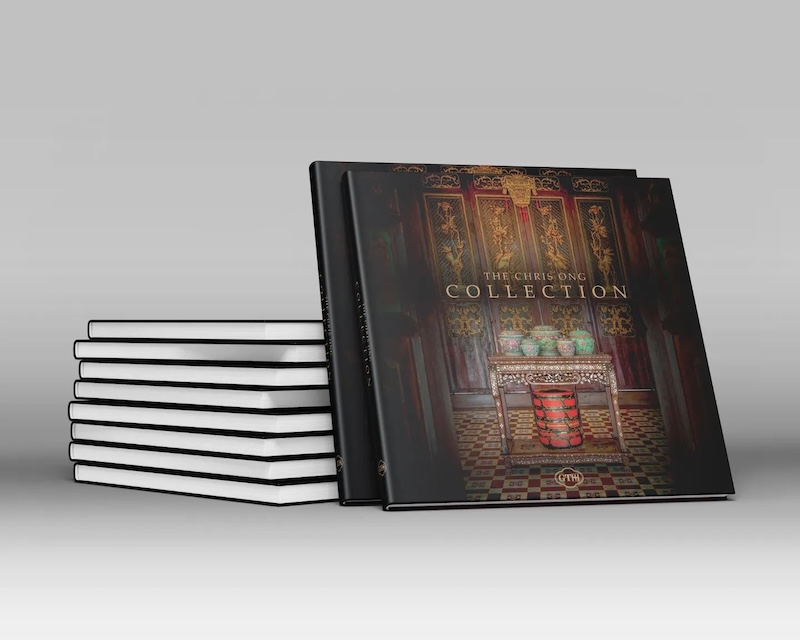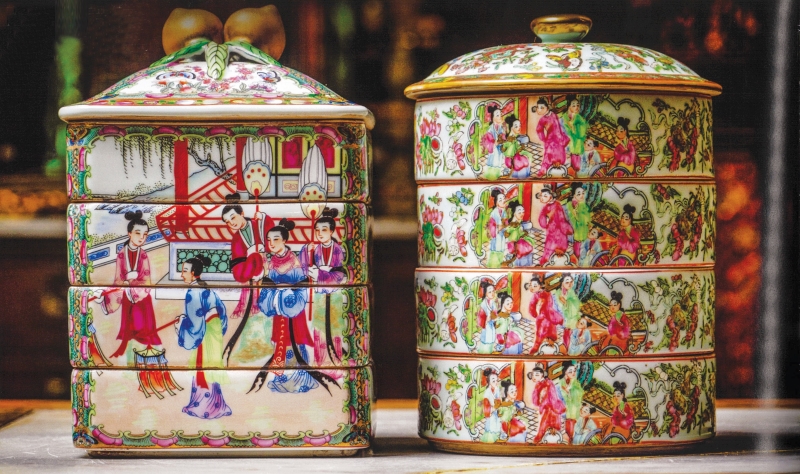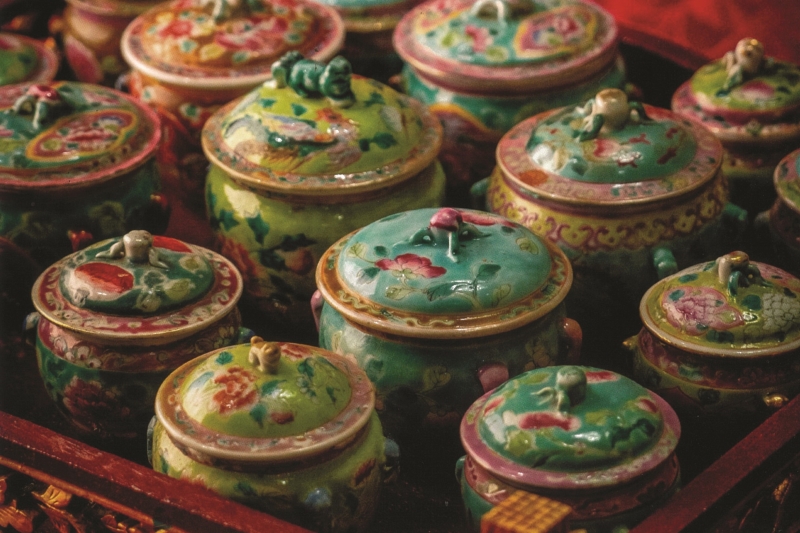
A typical offering table for the departed using blue and white plates, spoons and teacups (All photos: Chris Ong)
Collectors have different reasons for acquiring certain objects. Chris Ong’s is probably as unique as the rare antiques in his collection. “My grandmother used to tell me stories about her youth. The one I remember most is how she did not get her share of the porcelain she felt entitled to. As a young child, my quest was to get it back for her.”
Chris, a fifth-generation Penang-born Baba, was four when his maternal grandma was forced to leave her opulent Peranakan home to live with his parents after grandpa’s death. Ong Kooi Kee, granddaughter of Kapitan Cina Khaw Boo Aun, had chinaware, intricate silver art pieces and precious jewellery bestowed upon her when she married. She used to guzzle a bottle of Guinness Stout every day, Chris recalls. “She drank it as a tonic and it got her talking, non-stop. She would also have her cigar and sireh. She was fearless.”
Ong’s father had two wives who lived under the same roof. When her mother died, power passed on to the second wife, who did not distribute anything to her or her siblings. In The Chris Ong Collection, the eponymous author shares how grandma’s lament about having to surrender cherished possessions during WWII and not getting what rightfully belonged to her was the genesis of his collecting journey.
the_chris_ong_collection_book.jpeg

At the age of 12, Chris acquired his first pieces, a teacup and saucer adorned with the majestic phoenix the matriarch often reminisced about. “It felt like a first step towards restoring what had been lost.” When he presented them to Ong, she said, “We had a cupboard full of those.”
It would be another 30 years before Chris’ collection gained momentum. During that time, he left home for university, worked as an investment banker in Sydney, and opened the Galle Fort Hotel in Sri Lanka in 2004 with his then business partner Karl Steinberg. They restored a 17-century Dutch mansion to build the 12-suite boutique hotel. The project won a Unesco Asia-Pacific Heritage Award of Distinction for conservation.
In 2007, Chris returned home to Penang to care for his mother. The bank where he worked had been taken over and “it was a good time to reassess my career”.
Heeding his grandmother’s advice to grow, develop and create things for himself rather than wait to be given them, he founded George Town Heritage & Hotels, and began buying crumbling buildings and turning them into boutique hotels with 19th-century architecture but modern, hip interiors. “I like meeting guests. I’m good at it, but not operations.”
132_new.jpg

He sold Galle Fort and his first heritage hotel in Penang, Clove Hall, then went on to create more. Today, he owns Muntri Mews, Seven Terraces and Muntri Grove, all within the George Town Unesco World Heritage Site, and Jawi Peranakan Mansion, 50m from the edge of that zone.
Each restored property serves as a repository for the ornate porcelain Chris has amassed over the decades, particularly the focus of his collection — kam cheng (covered pots prized by the Peranakan Chinese), sweetmeat trays and tingkat (stackable food containers). These beautiful creations take up many pages in his book, which has stunning photos and details on their history, designs and colours, uses, the stories they hold and why they are prized.
Chris also has altar pieces, festive ware, Chinese bonbonnière, sauce dishes, tea paraphernalia, mother-of-pearl furniture, embroidery, banners, wedding jewellery and items that fill bridal chambers, black-and-gold lacquerware, teapots, cups, bowls and more.
There are things he never set out to acquire too, because when collectors purchase through an estate sale, they pick up the whole lot. He does not go searching for a particular piece because it would be like looking for a needle in a haystack.
“They come to you, if you’re lucky. Now that I have such a repertoire in my collection, finding things I don’t have is quite rare.” But examining his trove closely to describe them for his book was an eye-opener: He had missed the many details that make them unique.
He enjoys using his antique items at home. “It’s like recreating the past. You have no idea how many things and pieces of furniture voluminous old houses can hold,” says Chris, who lives in two that add up to about 10,000 sq ft in George Town.
14.jpg

“When guests stay in our hotels, it’s like stepping into a comfortable museum. I over-invest and over-capitalise.” Part of his mission of keeping a large archive of Peranakan furniture, textiles and porcelain is to stop them from going out of Penang. Lots had been acquired by, donated or lent to Singaporeans, he noted when the city state opened its Peranakan Museum in 2008.
This hotelier has another motive: to preserve the many stories passed down by old aunties, oral accounts highlighting the importance of rituals, traditions and how porcelain was used for different occasions. These sparked his imagination and interest in his roots.
“It’s about going behind why things were done the way they were and how things were used. I was always curious to know.” He also wants to educate collectors on what to look out for because there are many reproductions in the market.
Chris sees his hometown “going through a renaissance of quite a large magnitude. I was concerned it would become a theme park, like Disneyland. But it has grown organically”.
He sees his part as restoring decrepit property, adapting them into hotels, and documenting and sharing his intangible heritage, such as the cultural and religious practices that are dying out. “Basically, I was in here early. In a sense, I probably set a standard for others to follow because I’ve done [restoration] projects in Sri Lanka and Australia.”
pg41.jpg

Taking inspiration from the Jim Thompson House in Bangkok, he wants to create a house museum, funded by his own foundation, to preserve his collection for posterity. “Things are in place for that. I don’t mind doing things slowly and being more conservative in our growth and expansion. It’s just about being able to make a difference in my hometown.”
Knowing he is fully into what he is “supposed to be doing” makes him satisfied and content. “To realise this is your destiny is amazing. I lived overseas and had a successful career as a fund manager for 30 years. I never thought I’d return to George Town to do this.”
Is Chris still adding to his collection? “I believe more is more. You cannot have too much of a good thing.”
If grandma were still around today, what would he say to her?
“I would ask her, ‘Is it enough yet?’ But you know, being tiger mums and grannies, they are never satisfied. It’s never enough.”
'The Chris Ong Collection' (RM280) is available at Warong Old China. Whatsapp/message (013) 923 0979.
This article first appeared on Nov 4, 2024 in The Edge Malaysia.


